SIG MANUFACTURING'S
INTERESTING FACTS ABOUT BALSA WOOD
This is copied from the page at
the web site of Hobby Hobby Inc. The reason is that the original has
a Javascript to avoid its use outside the site.
Charts and Graphs
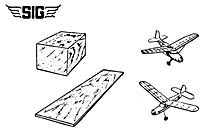 Model airplanes are no different than any other type of flying machine,
large or small - THE LIGHTER IT IS BUILT, THE BETTER IT WILL FLY!
With that in mind, it is easy to understand why balsa wood has been the
standard material for model airplane construction since it first became
readily available in the U.S. in the late 1920's. Its outstanding
strength-to-weight ratio enables hobbyists to construct durable models
that fly in totally realistic manner. Balsa also absorbs shock and
vibration well and can be easily cut, shaped, and glued with simple hand
tools.
Model airplanes are no different than any other type of flying machine,
large or small - THE LIGHTER IT IS BUILT, THE BETTER IT WILL FLY!
With that in mind, it is easy to understand why balsa wood has been the
standard material for model airplane construction since it first became
readily available in the U.S. in the late 1920's. Its outstanding
strength-to-weight ratio enables hobbyists to construct durable models
that fly in totally realistic manner. Balsa also absorbs shock and
vibration well and can be easily cut, shaped, and glued with simple hand
tools.
WHERE DOES BALSA WOOD COME FROM?
Balsa trees grow naturally in the humid rain forests of Central and South
America. Its natural range extends south from Guatemala, through Central
America, to the north and west coast of South America as far as Bolivia.
However, the small country of Ecuador, on the western coast of South
America, is the primary source of model aircraft grade balsa in the
world. Balsa needs a warm climate with plenty of rainfall and good
drainage. For that reason, the best stands of balsa usually appear on the
high ground between tropical rivers. Ecuador has the ideal geography and
climate for growing balsa trees. The scientific name for balsa wood is
ochroma lagopus. The word balsa itself is Spanish meaning raft, in
reference to its excellent flotation qualities. In Ecuador it is known as
Boya, meaning buoy.
HOW DOES BALSA WOOD GROW?
There is no such thing as entire forests of balsa trees. They grow singly
or in very small, widely scattered groups in the jungle. For hundreds of
years, balsa was actually considered a weed tree. They reproduce by
growing hundreds of long seed pods, which eventually open up and, with
the help of the wind, scatter thousands of new seeds over a large area of
the jungle. Each seed is airborne on its own small wisp of down, similar
to the way dandelion seeds spread. The seeds eventually fall to the
ground and are covered by the litter of the jungle. There they lay and
accumulate until one day there is an opening in the jungle canopy large
enough for the sun's rays to strike the jungle floor and start the seeds
growing. Wherever there was an opening, made either by a farmer or by
another tree dying, balsa will spring up as thick as grass. A farmer is
often hard put to keep his food plot clear of balsa. As the new balsa
trees grow, the strongest will become predominate and the weaker trees
will die. By the time they are mature, there may be only one or two balsa
trees to an acre of jungle.
HOW LONG DOES IT TAKE A BALSA TREE TO GROW?
Balsa trees grow very rapidly (like all pesky trees). Six months after
germination, the tree is about 1-1/2 inches in diameter and 10 - 12 feet
tall! In 6 to 10 years, the tree is ready for cutting, having reached a
height of 60 to 90 feet tall and a diameter of 12 to 45 inches. If left
to continue growing, the new wood being grown on the outside layers
becomes very hard and the tree begins to rot in the center. Unharvested,
a balsa tree may grow to a diameter of 6 feet or more, but very little
usable lumber can be obtained from a tree of this size. The balsa leaf is
similar in shape to a grape leaf, only a lot bigger. When the tree is
young, these leaves measure as much as 4 feet across. They become
progressively smaller as the tree grows older, until they are about 8 -
10 inches across. Balsa is one of the few trees in the jungle which has a
simple leaf shape. This fact alone makes the balsa tree stand out in the
jungle.
THE PERFECT NURSE!
Nature evidently designed the balsa tree to be a "nurse tree"
which would protect the slower-growing species of trees from the
scorching jungle sun during their critical early years. For instance, in
an area of the jungle that has been ravaged by a tropical storm or other
natural disaster, the balsa trees will quickly sprout and beginning to
shoot up to impressive heights in a very short time.Their fast growth,
and the extra large leaves they have in their early years, provide shade
to the young seedlings of the slower-growing forest giants. By the time
the seedlings are established enough to take care of themselves, the
balsa tree is beginning to die. Undoubtably, the balsa tree's rapid
growth, fast spreading crown of first very large and gradually smaller
leaves, and it's relatively short life span were intended to make it the
"perfect nurse" in the jungle ecosystem.
HOW ARE BALSA TREES HARVESTED?
While nature intended the balsa tree to be a short lived nursemaid,
mankind eventually discovered that it was an extremely useful resource.
The real start of the balsa business was during World War I, when the
allies were in need of a plentiful substitute for cork. The only draw
back to using balsa was, and still is, the back breaking work that is
necessary to get it out of the jungle. Because of the way the individual
balsa trees are scattered throughout the jungles, it has never been
possible to use mass production logging procedures and equipment. The
best way to log balsa trees is to go back to the methods of Paul Bunyan -
chop them down with an axe, haul them to the nearest river by ox team,
tie them together into rafts, and then float the raft of balsa logs down
the river to the saw mill. The logging team usually consists of two
native Ecquadorians, each armed with a broad Spanish axe, a machete, and
a long pole sharpened like a chisel on one end for removing the bark from
the downed trees. Because of the
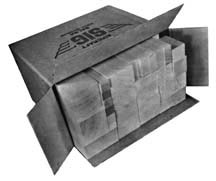 hilly terrain, an ox team may only be able to drag two logs to the river
per day. At the saw mill, the balsa is first rough cut into large boards,
then carefully kiln dried, and finally packed into bales for shipment to
the U.S. via ocean freighter.
hilly terrain, an ox team may only be able to drag two logs to the river
per day. At the saw mill, the balsa is first rough cut into large boards,
then carefully kiln dried, and finally packed into bales for shipment to
the U.S. via ocean freighter.
Final cutting and finishing of our model aircraft balsa is done
right here at the SIG factory. As a result of the balsa tree's fast
growth cycle, both the quality and lightness of the lumber obtained from
a balsa tree can vary enormously depending upon the tree's age at the
time of cutting.
WHY IS BALSA WOOD SO LIGHT?
The secret to balsa wood's lightness can only be seen with a microscope.
The cells are big and very thinned walled, so that the ratio of solid
matter to open space is as small as possible. Most woods have gobs of
heavy, plastic-like cement, called lignin, holding the cells together. In
balsa, lignin is at a minimum. Only about 40% of the volume of a piece of
balsa is solid substance. To give a balsa tree the strength it needs to
stand in the jungle, nature pumps each balsa cell full of water until
they become rigid - like a car tire full of air. Green balsa wood
typically contains five times as much water by weight as it has actual
wood substance, compared to most hardwoods which contain very little
water in relation to wood substance. Green balsa wood must therefore be
carefully kiln dried to remove most of the water before it can be sold.
Kiln drying is a tedious two week process that carefully removes the
excess water until the moisture content is only 6%. Kiln drying also
kills any bacteria, fungi, and insects that may have been in the raw
balsa wood.
HOW LIGHT IS KILN DRIED BALSA WOOD?
Finished balsa wood, like you find in model airplane kits, varies widely
in weight. Balsa is occasionally found weighing as little as 4 lbs. per
cu. ft. On the other hand, you can also find balsa which will weigh 24
lbs. or more per cu. ft.
However, the general run of commercial balsa for model airplanes will
weigh between 6 lbs. to 18 lbs. per cu. ft. Eight to twelve lb. balsa is
considered medium or average weight, and is the most plentiful. Six
pounds or less is considered "contest grade", which is very
rare and sometimes even impossible to obtain.
IS BALSA THE LIGHTEST WOOD IN THE WORLD?
No! Most people are surprised to hear that botanically, balsa wood is
only about the third or fourth lightest wood in the world. However, all
the woods which are lighter than balsa are terribly weak and unsuitable
for any practical use. The very lightest varieties don't really resemble
wood at all, as we commonly think of it, but are more like a tree-like
vegetable that grows in rings, similar in texture to an onion. It is not
until balsa is reached that there is any sign of real strength combined
with lightness. In fact, balsa wood is often considered the strongest
wood for its weight in the world. Pound for pound it is stronger in some
respects than pine, hickory, or even oak (see chart below).
STRENGTH OF BALSA WOOD COMPARED TO OTHER
WOODS
|
|
|
|
|
Balsa |
8 |
72 |
70 |
75 |
Balsa |
10 |
100 |
100 |
100 |
Balsa |
14 |
156 |
161 |
149 |
Spruce |
28 |
230 |
260 |
289 |
Yellow Pine |
28 |
222 |
277 |
288 |
Douglas Fir |
30 |
241 |
291 |
341 |
Hickory |
50 |
379 |
638 |
514 |
Oak |
48 |
295 |
430 |
366 |
Basswood |
26 |
261 |
288 |
288 |
Black Walnut |
37 |
301 |
506 |
512 |
Return to Top Menu
NOTE ABOUT CHART:
The strength of balsa varies in direct relation to its density or weight
- the heavier the wood the stronger it is. The above chart was designed
with 10 lb./cu. ft. balsa as the median. In other words, balsa at IO
Ibs./cu. ft. has been tested given a value of 100. The other woods were
then tested in the same way and given a figure that is numerically in
proportion. By comparing the relative strength figures in the chart, it
will be seen that balsa is as strong or stronger, pound for pound, than
most of the species shown.

Return to Top Menu
SELECTING BALSA FOR MODEL BUILDING:
Most hobby shops have a large rack of balsa sheets, sticks, and blocks
that you can choose from if you are going to build a model airplane from
scratch. Undoubtably, because of the nature of balsa, the actual weight
of each piece of wood of the same size can vary slightly. When you select
the pieces you want to buy, you keep their final use in mind. Logically
one should select the lightest grades for the lightly stressed model
parts (nose blocks, wingtip blocks, fill-ins, etc.), and the heavier
grades for important load bearing parts of the structure (spars, fuselage
stringers, etc.). To a large extent, this selection is already partly
done for you. Here at SIG, we purposely cut up our lightest raw balsa
into sticks. Sheets are cut in the entire wide range of density.
To give you any idea how much common sizes of balsa can vary in weight
depending upon the density of raw stock it was cut from, the following
three charts have been developed. They show the actual weight in ounces
of each size piece when it is cut from 6, 8, 10, 12, 14, or 18 lb..cu.
ft. stock. For example, in the first chart for BALSA SHEETS we see that a
1/16" x 3" x 36" sheet cut from 10 lb./cu. ft. stock will
weigh approximately .625 ounces. The same size sheet cut from 14 lb./cu.
ft. stock will weigh about .875 ounces.
Return to Top Menu
BALSA SHEETS
WEIGHT IN OUNCES
|
STOCK DENSITY in pounds per cubic foot |
6 |
8 |
10 |
12 |
14 |
16 |
1/32" x |
2" |
.125 |
.167 |
.211 |
.250 |
.291 |
.333 |
3" |
.1875 |
.250 |
.3125 |
.375 |
.4375 |
.500 |
4" |
.250 |
.333 |
.417 |
.500 |
.583 |
.667 |
1/16" x |
2" |
.250 |
.333 |
.417 |
.500 |
.583 |
.667 |
3" |
.375 |
.500 |
.625 |
.750 |
.875 |
1.000 |
4" |
.500 |
.667 |
.833 |
1.000 |
1.167 |
1.333 |
3/32" x |
2" |
.375 |
.500 |
.625 |
.750 |
.875 |
1.000 |
3" |
.5625 |
.750 |
.9375 |
1.125 |
1.3125 |
1.500 |
4" |
.750 |
1.000 |
1.125 |
1.500 |
1.750 |
2.000 |
1/8" x |
2" |
.500 |
.667 |
.833 |
1.000 |
1.167 |
1.333 |
3" |
.750 |
1.000 |
1.250 |
1.500 |
1.750 |
2.000 |
4" |
1.000 |
1.333 |
1.667 |
2.000 |
2.333 |
2.667 |
3/16" x |
2" |
.750 |
1.000 |
1.250 |
1.500 |
1.750 |
2.000 |
3" |
1.125 |
1.500 |
1.875 |
2.250 |
2.625 |
3.000 |
4" |
1.500 |
2.000 |
2.500 |
3.000 |
3.500 |
4.000 |
1/4" x |
2" |
1.000 |
1.333 |
1.667 |
2.000 |
2.333 |
2.667 |
3" |
1.500 |
2.000 |
2.500 |
3.000 |
3.500 |
4.000 |
4" |
2.000 |
2.667 |
3.333 |
4.000 |
4.667 |
5.333 |
3/8" x |
2" |
1.500 |
2.000 |
2.500 |
3.000 |
3.500 |
4.000 |
3" |
2.250 |
3.000 |
3.750 |
4.500 |
5.250 |
6.000 |
4" |
3.000 |
4.000 |
5.000 |
6.000 |
7.000 |
8.000 |
1/2" x |
2" |
2.000 |
2.667 |
3.333 |
4.000 |
4.667 |
5.333 |
3" |
3.000 |
4.000 |
5.000 |
6.000 |
7.000 |
8.000 |
4" |
4.000 |
5.333 |
6.667 |
8.000 |
9.333 |
10.667 |
Return to Top Menu
BALSA BLOCKS
WEIGHT IN OUNCES
|
STOCK DENSITY in pounds per cubic foot |
6 |
8 |
10 |
12 |
14 |
16 |
1" x |
1" |
2.0 |
2.667 |
3.333 |
4.0 |
4.667 |
5.333 |
1-1/2" |
3.0 |
4.0 |
5.0 |
6.0 |
7.0 |
8.0 |
2" |
4.0 |
5.333 |
6.667 |
8.0 |
9.333 |
10.667 |
2-1/2" |
5.0 |
6.667 |
8.333 |
10.0 |
11.667 |
13.333 |
3" |
6.0 |
8.0 |
10.0 |
12.0 |
14.0 |
16.0 |
1-1/2" x |
1-1/2" |
4.5 |
6.0 |
7.5 |
9.0 |
10.5 |
12.0 |
2" |
6.0 |
8.0 |
10.0 |
12.0 |
14.0 |
16.0 |
2-1/2" |
7.5 |
10.0 |
12.5 |
15.0 |
17.5 |
20.0 |
2" x |
2" |
8.0 |
10.666 |
13.333 |
16.0 |
18.667 |
21.333 |
2-1/2" |
10.0 |
13.333 |
16.667 |
20.0 |
23.333 |
26.667 |
3" |
12.0 |
16.0 |
20.0 |
24.0 |
28.0 |
32.0 |
2-1/2" x |
2-1/2" |
12.5 |
16.667 |
20.833 |
25.0 |
29.166 |
33.333 |
3" |
15.0 |
20.0 |
25.0 |
30.0 |
35.0 |
40.0 |
3" |
3" |
18.0 |
24.0 |
30.0 |
36.0 |
42.0 |
48.0 |
4" |
24.0 |
32.0 |
40.0 |
48.0 |
56.0 |
64.0 |
Return to Top Menu
BALSA STICKS
WEIGHT IN OUNCES
SIZE
36" x |
# pieces |
STOCK DENSITY in pounds per cubic foot |
6 |
8 |
10 |
12 |
14 |
16 |
1/16" x |
1/16" |
16 |
.125 |
.167 |
.208 |
.250 |
.292 |
.333 |
3/32" |
16 |
.188 |
.250 |
.312 |
.375 |
.438 |
.500 |
1/8" |
8 |
.125 |
.167 |
.208 |
.250 |
.292 |
.333 |
3/16" |
8 |
.188 |
.250 |
.312 |
.375 |
.438 |
.500 |
1/4" |
4 |
.125 |
.167 |
.208 |
.250 |
.292 |
.333 |
3/8" |
4 |
.188 |
.250 |
.312 |
.375 |
.438 |
.500 |
1/2" |
2 |
.125 |
.167 |
.208 |
.250 |
.292 |
.333 |
3/32" x |
3/32" |
8 |
.141 |
.188 |
.234 |
.281 |
.326 |
.375 |
1/8" |
8 |
.188 |
.250 |
.312 |
.375 |
.438 |
.500 |
3/16" |
4 |
.141 |
.188 |
.234 |
.281 |
.326 |
.375 |
1/4" |
4 |
.188 |
.250 |
.312 |
.375 |
.438 |
.500 |
3/8" |
2 |
.141 |
.188 |
.234 |
.281 |
.326 |
.375 |
1/2" |
2 |
.188 |
.250 |
.312 |
.375 |
.438 |
.500 |
1/8" x |
1/8" |
4 |
.125 |
.167 |
.208 |
.250 |
.292 |
.333 |
3/16" |
4 |
.188 |
.250 |
.312 |
.375 |
.438 |
.500 |
1/4" |
4 |
.250 |
.333 |
.416 |
.500 |
.538 |
.667 |
3/8" |
2 |
.188 |
.250 |
.312 |
.375 |
.438 |
.500 |
1/2" |
1 |
.125 |
.167 |
.208 |
.250 |
.292 |
.333 |
3/16" x |
3/16" |
2 |
.141 |
.188 |
.234 |
.281 |
.326 |
.375 |
1/4" |
2 |
.188 |
.250 |
.312 |
.375 |
.438 |
.500 |
3/8" |
2 |
.281 |
.375 |
.469 |
.563 |
.656 |
.750 |
1/2" |
1 |
.188 |
.250 |
.312 |
.375 |
.438 |
.500 |
3/4" |
1 |
.281 |
.375 |
.469 |
.563 |
.656 |
.750 |
1" |
1 |
.375 |
.500 |
.625 |
.750 |
.876 |
1.00 |
1/4" x |
1/4" |
1 |
.125 |
.167 |
.208 |
.250 |
.292 |
.333 |
3/8" |
1 |
.188 |
.250 |
.312 |
.375 |
.438 |
.500 |
1/2" |
1 |
.250 |
.333 |
.416 |
.500 |
.583 |
.667 |
3/4" |
1 |
.375 |
.500 |
.625 |
.750 |
.876 |
1.00 |
1" |
1 |
.500 |
.667 |
.832 |
1.00 |
1.166 |
1.333 |
3/8" x |
3/8" |
1 |
.281 |
.375 |
.469 |
.563 |
.656 |
.750 |
1/2" |
1 |
.375 |
.500 |
.625 |
.750 |
.876 |
1.00 |
1/2" x |
1/2" |
1 |
.500 |
.667 |
.832 |
1.00 |
1.166 |
.1333 |
1" |
1 |
1.00 |
1.333 |
1.666 |
2.00 |
2.333 |
2.667 |
3/4" x |
3/4" |
1 |
1.125 |
1.500 |
1.875 |
2.250 |
2.625 |
3.00 |
Return to Top Menu
COMMON MODELER'S TOOLS FOR CUTTING AND SHAPING BALSA
WOOD: Balsa is a very 'friendly" wood to work with - so light, so soft, so easily
worked into so many things. You don't need heavyduty power saws and sanders like you would
if working with a hardwood. In fact, even with an extensive power shop at their disposal,
the professional model builders here at the SIG factory find that they still rely
primarily on 4 or 5 simple hand tools for the majority of their work. If you are just
starting out in the model airplane hobby, here are the tools that they recommend that you
get:
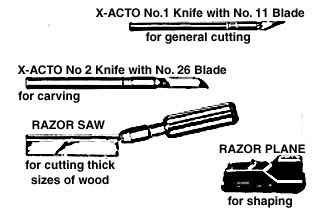
A knife or razor blade will work well for cutting balsa sheets and sticks
up to 3/16" thick. Use a razor saw for sizes thicker than
3/16". Always keep replacement blades on hand - blades do wear out
and a dull blade can make it impossible to do a good job.

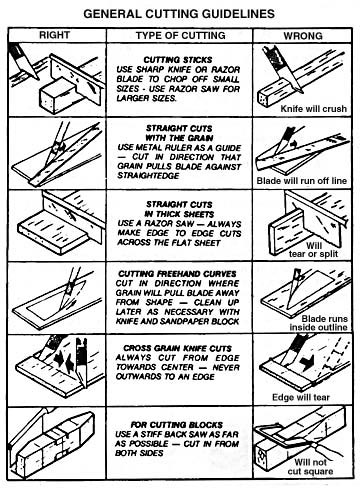
YOU WILL ALSO NEED SANDING BLOCKS:
In addition to the cutting tools, you will need an assortment of
different size sanding blocks. These are indispensable tools for model
construction. You can buy ready-made sanding blocks or make your own. The
most often used general purpose sanding block in our model shop is made
simply by wrapping a full 9" x 11" sheet of sandpaper around a
3/4" x 3" x 11" hardwood or plywood block. Use three
screws along one edge to hold the overlapped ends of the sandpaper in
place. Use 80 grit garnet sandpaper on the block during general
construction.
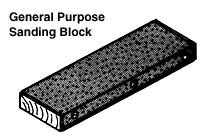
Another handy sanding block to have can be made by gluing 80 grit garnet
sandpaper onto a 24" or 36" long piece of aluminum channel
stock. Most hardware stores carry a rack of aluminum in various sizes and
shapes. This long sanding block is very helpful for shaping leading and
trailing edges, and other large pieces, accurately.
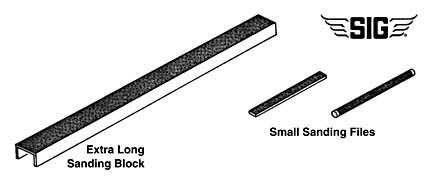
Last, but not least, glue sandpaper onto different sizes of scrap plywood
sticks and round hardwood dowels. These are handy for working in tight
places and for careful shaping where a big sanding block is too hard to
control.
Return to Top Menu
BALSA GRAIN I.D. CHART
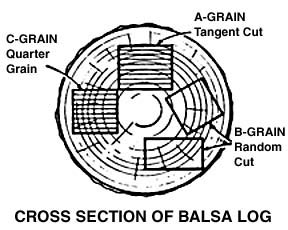 In selecting balsa sheets for use in your model, it is important to
consider the way the grain runs through the sheet as well as the weight
of the sheet. The grain direction actually controls the rigidity or
flexibility of a balsa sheet more than the density does. For example, if
the sheet is cut from the log so that the tree's annular rings run across
the thickness of the sheet (A-grain, tangent cut), then the sheet will be
fairly flexible edge to edge. In fact, after soaking in water some
tangent cut sheets can be completely rolled into a tube shape without
splitting. If on the other hand the sheet is cut with the annular rings
running through the thickness of the sheet (C-grain, quarter grain), the
sheet will be very rigid edge to edge and cannot be bent without
splitting. When the grain direction is less clearly defined (B-grain,
random cut), the sheet will have intermediate properties between A and C
grain. Naturally, B-grain is the most common and is suitable for most
jobs. The point to bear in mind is that whenever you come across pure
A-grain or C-grain sheets, learn where to use them to take best advantage
of their special characteristics. The following chart illustrates the 3
basic grain types for sheet balsa and lists the most appropriate uses for
each.
In selecting balsa sheets for use in your model, it is important to
consider the way the grain runs through the sheet as well as the weight
of the sheet. The grain direction actually controls the rigidity or
flexibility of a balsa sheet more than the density does. For example, if
the sheet is cut from the log so that the tree's annular rings run across
the thickness of the sheet (A-grain, tangent cut), then the sheet will be
fairly flexible edge to edge. In fact, after soaking in water some
tangent cut sheets can be completely rolled into a tube shape without
splitting. If on the other hand the sheet is cut with the annular rings
running through the thickness of the sheet (C-grain, quarter grain), the
sheet will be very rigid edge to edge and cannot be bent without
splitting. When the grain direction is less clearly defined (B-grain,
random cut), the sheet will have intermediate properties between A and C
grain. Naturally, B-grain is the most common and is suitable for most
jobs. The point to bear in mind is that whenever you come across pure
A-grain or C-grain sheets, learn where to use them to take best advantage
of their special characteristics. The following chart illustrates the 3
basic grain types for sheet balsa and lists the most appropriate uses for
each.
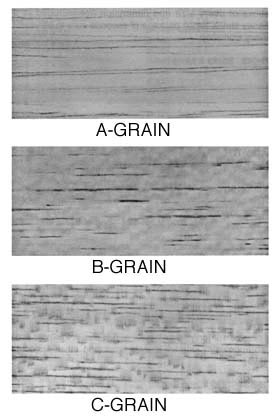 A-GRAIN sheet
balsa has long fibers that show up as long grain lines. It is very
flexible across the sheet and bends around curves easily. Also warps
easily. Sometimes called "tangent cut".
A-GRAIN sheet
balsa has long fibers that show up as long grain lines. It is very
flexible across the sheet and bends around curves easily. Also warps
easily. Sometimes called "tangent cut".
DO:
Use for sheet covering rounded fuselages and wing leading edges, planking
fuselages, forming tubes, strong flexible spars, HL glider fuselages.
DON'T:
Use for sheet balsa wings or tail surfaces, flat fuselage sides, ribs, or
formers.
B-GRAIN
sheet balsa has some of the qualities of both type A and type C. Grain
lines are shorter than type A, and it feels stiffer across the sheet. It
is a general purpose sheet and can be used for many jobs. Sometimes
called "random cut".
DO:
Use for flat fuselage sides, trailing edges, wing ribs, formers, planking
gradual curves, wing leading edge sheeting.
DON'T:
Use where type A or type C will do a significantly better job.
C-GRAIN
sheet balsa has a beautiful mottled appearance. It is very stiff across
the sheet and splits easily. But when used properly, it helps to build
the lightest strongest models. Most warp resistant type. Sometimes called
"quarter grain".
DO:
Use for sheet balsa wings and tails, flat fuselage sides, wing ribs,
formers, trailing edges. Best type for HL glider wings and tails.
DON'T:
Use for curved planking, rounded fuselages, round tubes, HL glider
fuselage, or wing spars.
Return to Top Menu
 Model airplanes are no different than any other type of flying machine,
large or small - THE LIGHTER IT IS BUILT, THE BETTER IT WILL FLY!
With that in mind, it is easy to understand why balsa wood has been the
standard material for model airplane construction since it first became
readily available in the U.S. in the late 1920's. Its outstanding
strength-to-weight ratio enables hobbyists to construct durable models
that fly in totally realistic manner. Balsa also absorbs shock and
vibration well and can be easily cut, shaped, and glued with simple hand
tools.
Model airplanes are no different than any other type of flying machine,
large or small - THE LIGHTER IT IS BUILT, THE BETTER IT WILL FLY!
With that in mind, it is easy to understand why balsa wood has been the
standard material for model airplane construction since it first became
readily available in the U.S. in the late 1920's. Its outstanding
strength-to-weight ratio enables hobbyists to construct durable models
that fly in totally realistic manner. Balsa also absorbs shock and
vibration well and can be easily cut, shaped, and glued with simple hand
tools. hilly terrain, an ox team may only be able to drag two logs to the river
per day. At the saw mill, the balsa is first rough cut into large boards,
then carefully kiln dried, and finally packed into bales for shipment to
the U.S. via ocean freighter.
hilly terrain, an ox team may only be able to drag two logs to the river
per day. At the saw mill, the balsa is first rough cut into large boards,
then carefully kiln dried, and finally packed into bales for shipment to
the U.S. via ocean freighter.





 In selecting balsa sheets for use in your model, it is important to
consider the way the grain runs through the sheet as well as the weight
of the sheet. The grain direction actually controls the rigidity or
flexibility of a balsa sheet more than the density does. For example, if
the sheet is cut from the log so that the tree's annular rings run across
the thickness of the sheet (A-grain, tangent cut), then the sheet will be
fairly flexible edge to edge. In fact, after soaking in water some
tangent cut sheets can be completely rolled into a tube shape without
splitting. If on the other hand the sheet is cut with the annular rings
running through the thickness of the sheet (C-grain, quarter grain), the
sheet will be very rigid edge to edge and cannot be bent without
splitting. When the grain direction is less clearly defined (B-grain,
random cut), the sheet will have intermediate properties between A and C
grain. Naturally, B-grain is the most common and is suitable for most
jobs. The point to bear in mind is that whenever you come across pure
A-grain or C-grain sheets, learn where to use them to take best advantage
of their special characteristics. The following chart illustrates the 3
basic grain types for sheet balsa and lists the most appropriate uses for
each.
In selecting balsa sheets for use in your model, it is important to
consider the way the grain runs through the sheet as well as the weight
of the sheet. The grain direction actually controls the rigidity or
flexibility of a balsa sheet more than the density does. For example, if
the sheet is cut from the log so that the tree's annular rings run across
the thickness of the sheet (A-grain, tangent cut), then the sheet will be
fairly flexible edge to edge. In fact, after soaking in water some
tangent cut sheets can be completely rolled into a tube shape without
splitting. If on the other hand the sheet is cut with the annular rings
running through the thickness of the sheet (C-grain, quarter grain), the
sheet will be very rigid edge to edge and cannot be bent without
splitting. When the grain direction is less clearly defined (B-grain,
random cut), the sheet will have intermediate properties between A and C
grain. Naturally, B-grain is the most common and is suitable for most
jobs. The point to bear in mind is that whenever you come across pure
A-grain or C-grain sheets, learn where to use them to take best advantage
of their special characteristics. The following chart illustrates the 3
basic grain types for sheet balsa and lists the most appropriate uses for
each. A-GRAIN sheet
balsa has long fibers that show up as long grain lines. It is very
flexible across the sheet and bends around curves easily. Also warps
easily. Sometimes called "tangent cut".
A-GRAIN sheet
balsa has long fibers that show up as long grain lines. It is very
flexible across the sheet and bends around curves easily. Also warps
easily. Sometimes called "tangent cut".